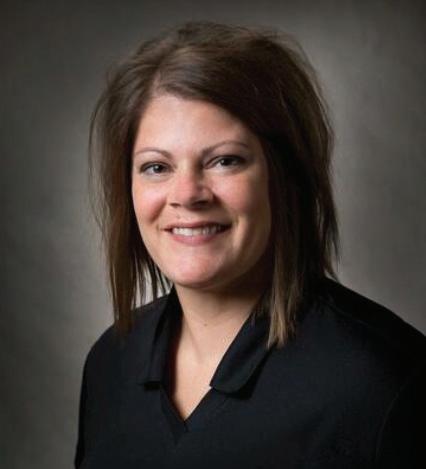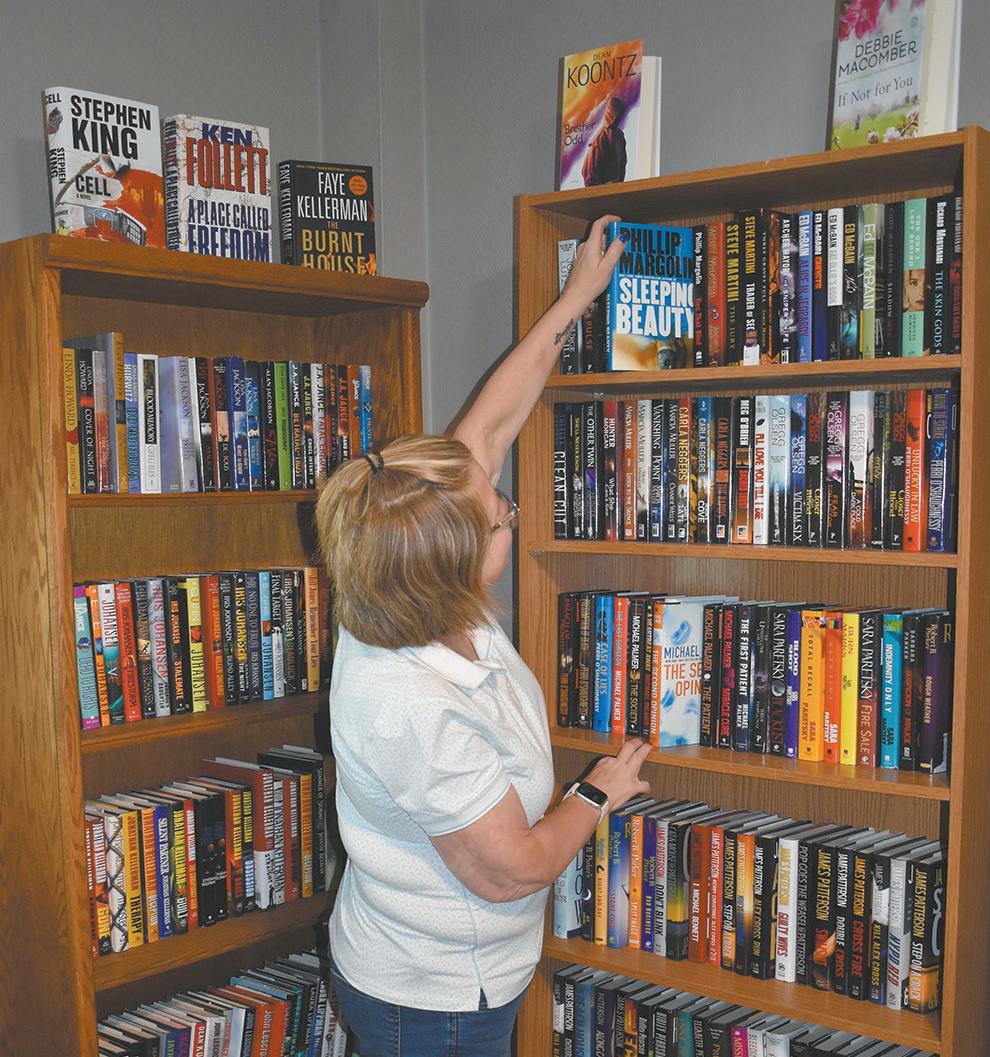


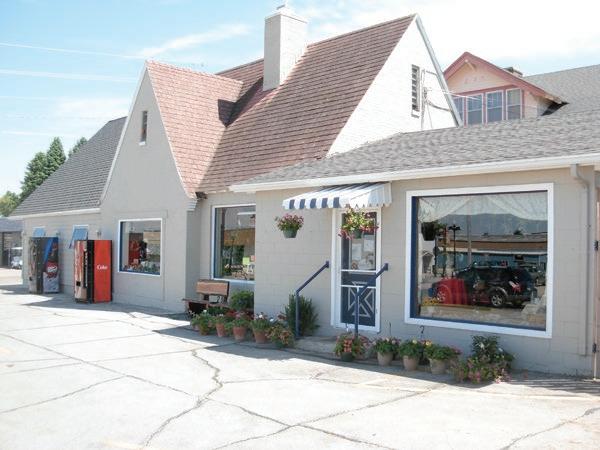
















By CHRIS FULLERTON
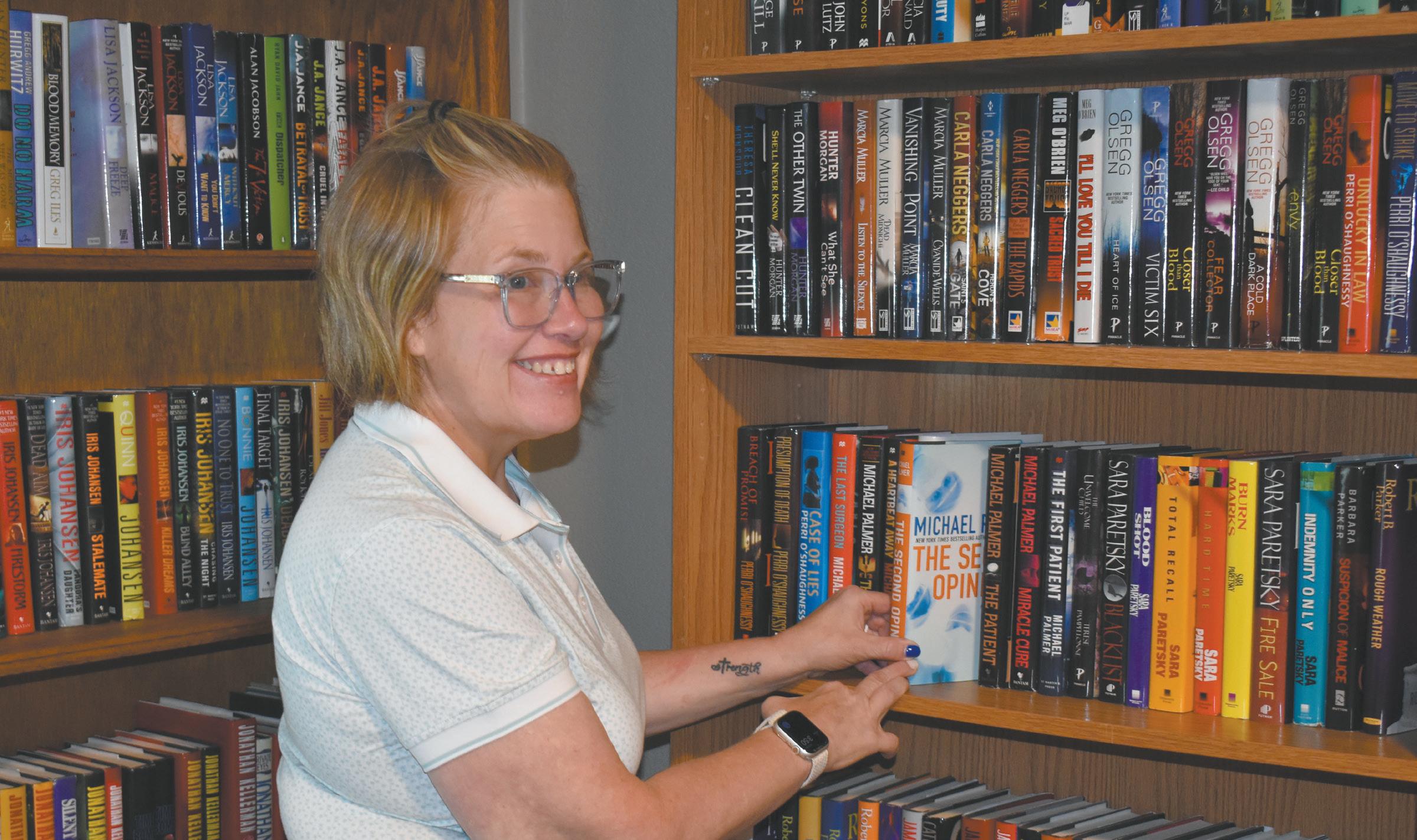

Webster City’s only used book store is a new collaboration between the Kendall Young Library and Friends of the Kendall Young Library. It solves a problem and creates an opportunity for local book lovers.
Kendall Young Library had a storage problem.
Webster City did not have a book store.
“So the idea for this started as a place to store the books that we were getting and pulling off the shelf, as well as getting donated for the library,” Ann McLaughlin, a library employee and a member of the Friends of the Library board. “As I got talking to Mary (Fortune) about it, she said, well, why don’t you just have your book sale here.”
Here is Shanti Rejuvenation Center, 914 Willson Avenue, Webster City. Fortune owns the business and the building. Right now, though, the building is on the market and Fortune plans to retire. She is letting The Book Place operate rent-free, for now.
“Friends of libraries across the state are starting their own used bookstores,” McLaughlin explained. “And this meant we wouldn’t have to move things back and forth between the library and here at this site. We know that Mary is looking to sell her building, so we will likely have to move at some point. But the idea is that we will stay here as long as possible. Every Thursday and every Saturday. And if there is more interest, we can be open, you know, with volunteers we can be
open more days and that kind of thing.”
The store is run by board members Karon Mason, Cheryl Eichler and Ann McLaughlin. But they welcome more volunteers. With more volunteers, the store could expand its hours, McLaughlin said.

Books in the stacks at The Book Place mainly come from two sources: donated books and books removed from the collection at Kendall Young Library, according to Kendall Young’s Director Ketta Lubbersted-Arjes.

The Iowa Library Association sets a requirement that on average 3% of all library collections should be removed from the collection, considering the amount of use, condition of the book, or obsolete materials.
That process is called weeding the collection. It’s something every library needs to do to keep its collection fresh and current. Locally, the weeded books go into boxes in the lower level of the library to await the annual book sale. Weeded books, along with donations from the public have overflowed the storage capacity of the library.
Because of this, Kendall Young Library has quickly filled up its available storage space.
McLaughlin first suggested the idea of a used book store because she remembers The Book Nook from her childhood in Webster City and longed to see such a place again.
Now she hopes that The Book Place will become a permanent fixture with the help of loyal customers and volunteers. Right now, the bookstore will be open every Thursday from noon to 2 p.m. and Saturdays from 10 a.m. to 2 p.m.
Hardback books are $1; paperbacks are 50 cents. Games, puzzles and movies are also available.
Customers will find many of their favorite authors on hand such as James Patterson, John Sanford, Janet Evanovich, Harlen Coben, J.D. Robb, and Mary Higgins Clark.


Treasure hunters will delight as they are encouraged to dig through overflow bins full of cookbooks, gardening books and thrillers.
Customers are also encouraged to write a list of their favorite authors so that more books can be brought over from storage as they become available. The library and The Book Place are not currently accepting donations, however.

By Richard Louv


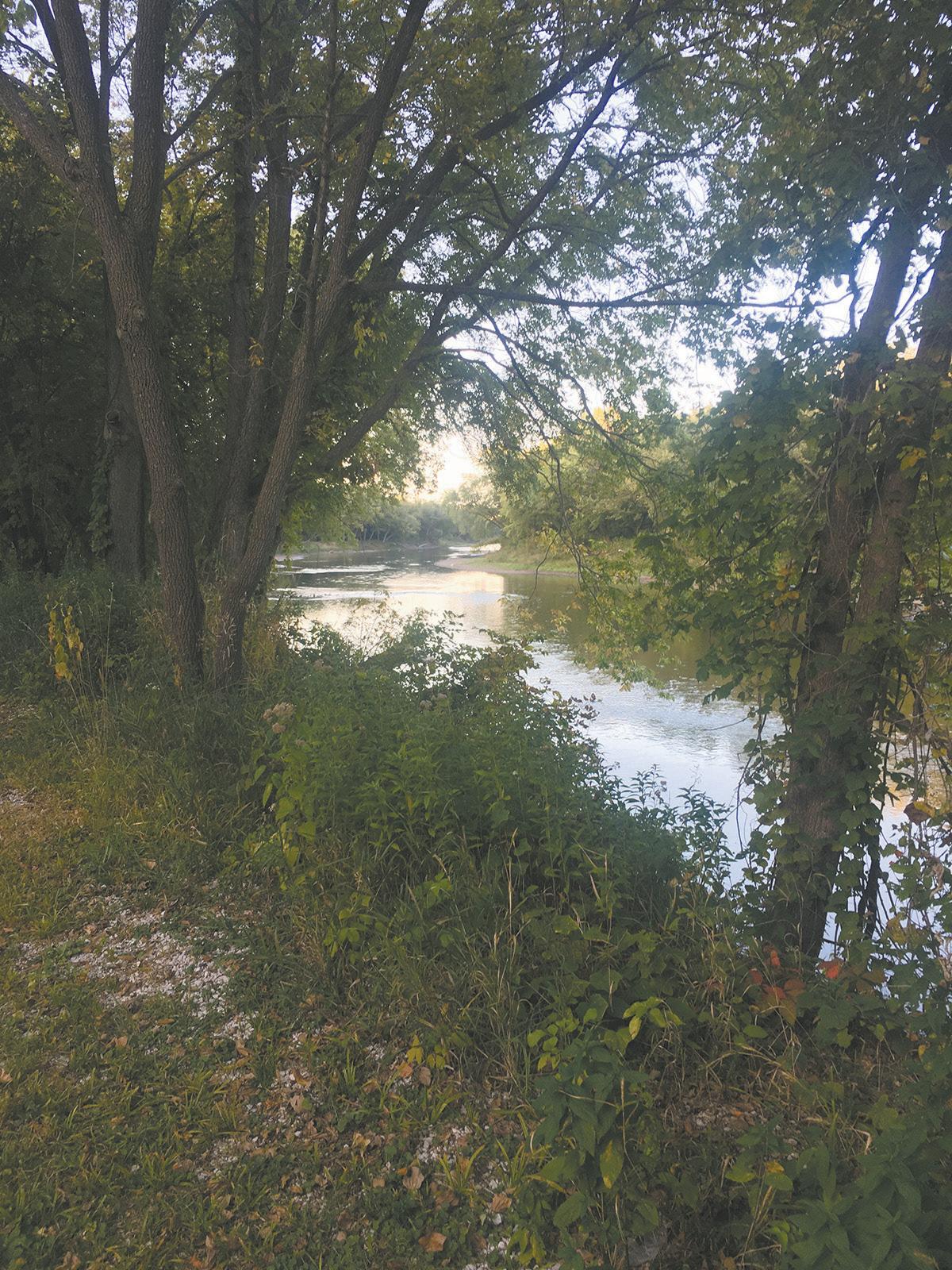
for children to learn how to interact with nature.
Louv leads the battle against Nature Deficit Disorder
It was John Laird at Hamilton County Conservation who first recommended Richard Louv’s Last Child in the Woods national bestseller to me many years ago. I think Laird would be pleased to know that my copy is now literally falling apart. I have used it so much, quoted it so often in different pieces, that the pages are falling out.

Photos and
Walking a field road can be a healthy diversion in the fight against Nature Deficit Disorder.
There’s nothing worse than a book that just sits on shelf — unless it’s a child who just sits inside. First published in 2005, Last Child in the Woods seeks to save today’s children from what he terms as “Nature-Deficit Disorder.”
Perhaps my favorite quote from this book is from a child who explained that he preferred playing inside, “because that’s where all the electrical outlets are.”
It’s been 20 years since this book was first published — and things have only gotten worse. That was roughly the time when the first smart phones came on to the scene, and most of society now has a neck ache from staring at tiny little screens for hours on end.
Yet another child in this book laments that folks of my generation — we Baby Boomers – seemed to have more fun when we were kids. Well, my friends and I certainly had tons of fun. We were free range kids just about every Sunday at Briggs Woods Park. We came out of the woods muddy, tired, sunburned, and with the occasional tick that had to be pried loose with mother’s trusty needle nose pliers. She was expert at getting under the tick and pulling in off cleanly.
My brother and his friend even hiked into the cornfield, found a spot to put up a pup tent, hoisted a flag above, and had a memorable campout in the middle of the field.
On our family farm, when friends came to visit we pretended we were characters on Gunsmoke in our barn, which served as Marshall Dillon’s jail and Miss Kitty’s Long Branch Saloon. We stayed out late playing Capture the Flag and Kick the Can.
Our parents knew how to wear us out so that we slept at night.
This unorganized play, Louv maintains, is essential for children. He really builds a compelling case that kids are hard-wired for nature. Our brains need time outside, and the need for outdoor time really doesn’t diminish with age. If we want to grow young artists and poets, they need to get outside and experience the symphony of nature.
Louv is a big fan of fishing, but not so much of games such as soccer and other organized recreation. A child needs a good “thinking place.” He needs a place to sit and watch butterflies, or gaze at the creatures swimming in a mudhole.
Yes, there are risks outside. Every stranger is a danger, ticks carry disease, and barns have rusty nails. But we fail to recognize that sitting inside for hours on end carries its own risk. Brain power and the imagination shrink, while the waistline grows. Childhood obesity is a growing health risk, but a few hours at a park can put a dent in it and build good habits for lifetime.
Well, folks, summer is here. It goes fast, and it’s time to do something about that. It’s time build up your reserves of “Vitamin N.”
“Vitamin N: The Essential Guide to Nature-Rich Life” is one of Lou’s most recent works. Since first directing his efforts to children, he has broadened his reach to delve into the fact that adults are also spending less and less time in nature.
Find a thinking place, a quiet place, where you will be sure to collect some mosquito bites and a bit of a sunburn. It will do you good. Hamilton County is blessed with such wonderful parks and nature areas. Pack a lunch and hit the road. Leave your phone in the car. Your brain will thank you for it.



wants to remind
you of some important tips on how to
1. Playing in the water

- Have a personal flotation device on in all bodies of water
- Be careful of blue- algae in lakes
- When swimming in a pool, make sure an adult is supervising
2. Playing outside
- Stay hydrated, its hot out, drink lots of water
- Use sunscreen, burns cause cancer
- Keep an eye out for kids on bikes, scooters, and other toys
- Use bug spray for mosquitos
- Wear your helmet if riding a bike
3. Grilling outside
- Keep grill at least 10 ft. from house
- Turn propane off when not in use
4. Severe Weather
- Keep up to date on weather alerts
- Know where to go if there are watches or warnings
5. Pets
- Keep your pets watered, they get hot too
- Make sure they have ability to get into the shade on hot days

Our Hometown Recipe Corner

Grilling is a passion shared by millions of people across the globe. For some, there’s simply no better way to prepare meals in summertime than to do so over an open flame.
Recent years have seen many people expand their culinary horizons beyond traditional grilling fare like hamburgers and hot dogs. Indeed, there’s











no shortage of options for grilling afficionados looking to expand their repertoire. Individuals who love seafood can try this recipe for “Grilled Diver Scallops and Fall Vegetable Shish Kebabs with Hazelnut Brown Butter” courtesy of John Holl’s “The American Craft Beer Cookbook” (Storey).








Makes 4 servings
12 fresh large diver scallops
4 fennel bulbs, trimmed, cored, and diced into 1 1⁄2-inch cubes
4 large parsnips, peeled and diced into 11⁄2-inch cubes
1 medium butternut squash, peeled, seeded, and diced into 11⁄2-inch cubes
2 tablespoons extra-virgin olive oil
Salt and freshly ground black pepper
1 12-ounce can beer
8 skewers
1 cup (2 sticks) unsalted butter
1 tablespoon finely chopped toasted hazelnuts
1. Remove the scallops from the refrigerator to come up to room temperature. Prepare a medium fire in a gas or charcoal grill. If using charcoal, arrange the coals in a thin layer to evenly control the heat.
2. Combine the fennel, parsnips, and butternut squash in a large bowl and toss with 1 tablespoon of the olive oil. Transfer the vegetables to a cast-iron skillet (or another grill-safe pan), season with salt and pepper, and place the pan on the grill. Cook, with the lid closed, stirring occasionally, until the vegetables are a light golden brown, about 25 minutes.
3. Remove the skillet from the grill and deglaze with 1⁄4 cup of the beer. Remove the vegetables from the skillet and let cool for 5 minutes. Reserve any drippings in the skillet for later.
4. Using two skewers for each shish kebab, alternately thread the scallops, fennel, parsnips, and butternut squash onto the skewers. Using two skewers for each kebab will prevent the ingredients from spinning on the grill.
5. Season the kebabs with salt and pepper and lightly coat with the remaining 1 tablespoon olive oil. Grill the kebabs, turning once, until you’ve reached the desired level of doneness for the scallops, about 5 minutes per side for medium. Set aside and tent with foil while making the sauce.
6. Return the skillet to the grill; add the butter, hazelnuts, and remaining 11⁄4 cups beer to the vegetable drippings. Cook, stirring occasionally, until the butter is melted and lightly browned.
7. Transfer the kebabs to a serving plate, pour the brown butter sauce over the scallops, and serve immediately.
Look at these photos and see if you can identify these local landmarks. No Winner Last 2 Months
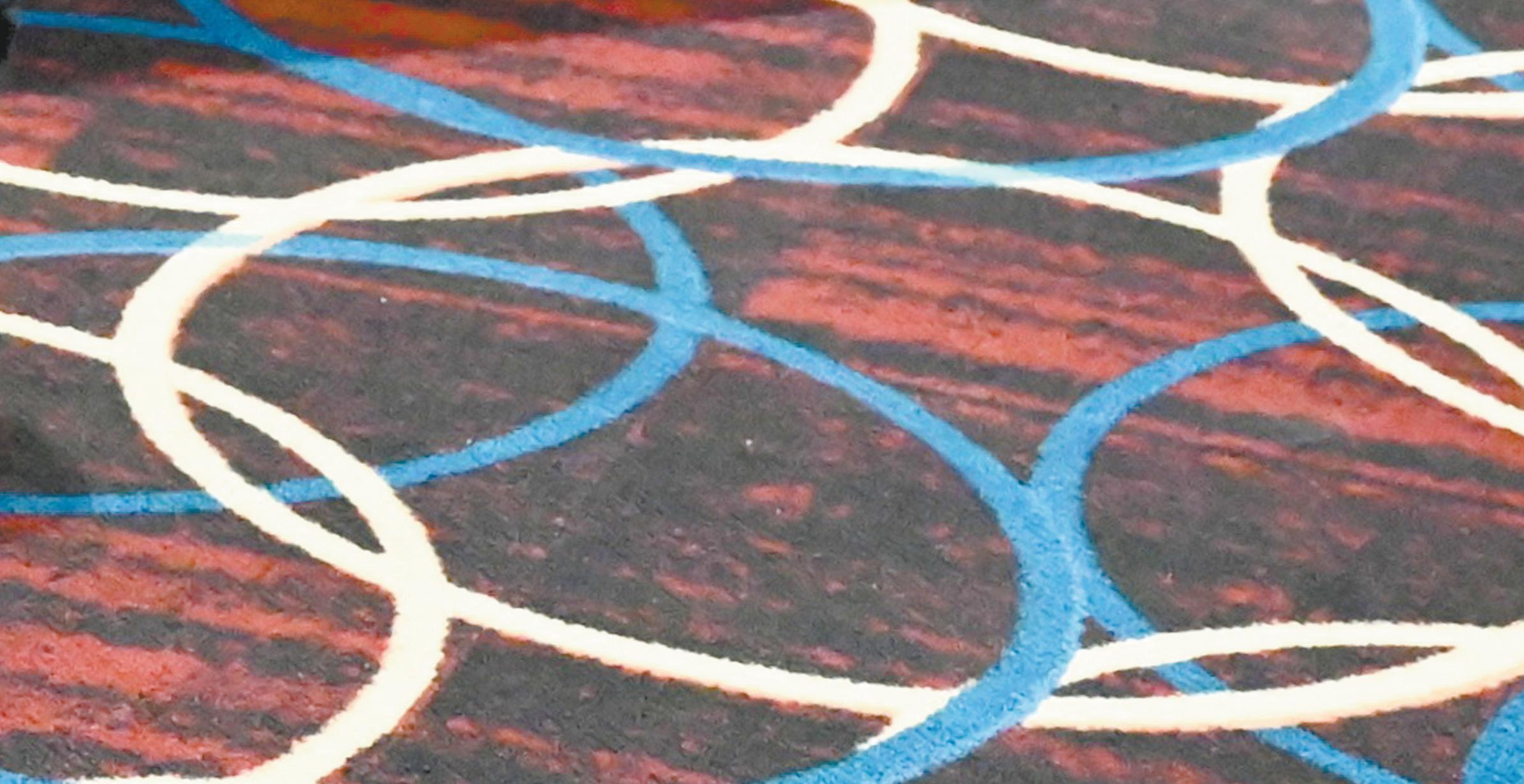
Photo No. 1: Church of Christ, 900 Des Moines Street, Webster City
Photo No. 2: First Congregational United Church of Christ, 1000 Willson Avenue, Webster City


by Jim Miller
Dear Savvy Senior ,
What do I need to do to get disability benefits from Social Security?
I’m 60 years old and have a medical condition that doesn’t allow me to work at my job anymore, but I’ve read that getting disability benefits is very difficult.
Getting Social Security Disability Insurance benefits (SSDI) when you’re unable to work can indeed be challenging. Each year, approximately 2 million people apply for SSDI, but around two-thirds of them are denied, because most applicants fail to prove that they’re disabled and can’t work. Here are some steps you can take that can help improve your odds.
The first thing you need to find out is if your health condition qualifies you for Social Security disability benefits.
You generally will be eligible only if you have a physical or mental impairment severe enough that it prevents you from working in your current, or past line of work, for at least a year.
There is no such thing as a partial disability benefit. If you’re fit enough to work part-time, and you’re earning more than $1,620 ($2,700 if you’re blind) a month on average in 2025, your application will be denied. But, if you’re not working or are working but earning below those limits, your application may be considered.
Your skills, education and work experience are factors too. Your application will be denied if your work history suggests that you could perform a less physically demanding job that your disability does not prevent you from doing.
To help you determine if you’re eligible, use the SSA Benefit Eligibility Screening Tool at SSAbest.benefits.gov.
If you believe you have a claim, your next step is to gather up your personal, financial and medical information so you can be prepared and organized for the application process.
You can apply either online at SSA.gov/disability or call 800-772-1213 to make an appointment to apply at your local Social Security office, or to set up an appointment for someone to take your claim over the phone.
The whole process lasts about an hour. If you schedule an appointment, a “Disability Starter Kit” that will help you get ready for your interview will be mailed to you. If you apply online, the kit is available at SSA.gov/disability/disability_starter_kits.htm.
It currently takes six to eight months from the initial application to receive either an award or denial of benefits. The only exception is if you have a chronic illness that qualifies you for a “compassionate allowance” (see SSA.gov/compassionateallowances), which fast tracks cases within weeks.
If Social Security denies your initial application, you can appeal the decision, and you’ll be happy to know that roughly half of all cases that go through a round or two of appeals end with benefits being awarded. But the bad news is, with a huge backlog of people waiting, it can take another eight to 10 months or longer to appeal the decision, and another 15 months to get a hearing if reconsideration is denied.
You can hire a representative to help you with your Social Security disability claim. By law, representatives can charge only 25 percent of past-due benefits up to a maximum of $9,200 if they win your case.
It’s probably worth hiring someone at the start of the application process if your disability is something difficult to prove such as chronic pain. If, however, your disability is obvious, it might be worth initially working without a representative to avoid paying the fee. You can always hire a representative later if your initial application and first appeal are denied.
To find a representative, check with the National Organization of Social Security Claimants’ Representatives (nosscr.org) or National Association of Disability Representatives (nadr.org). Or, if you’re low-income, contact the Legal Services Corporation (lsc.gov/find-legal-aid) for free assistance.
Jim Miller is a contributor to the NBC Today show and author of “The Savvy Senior” book.









































